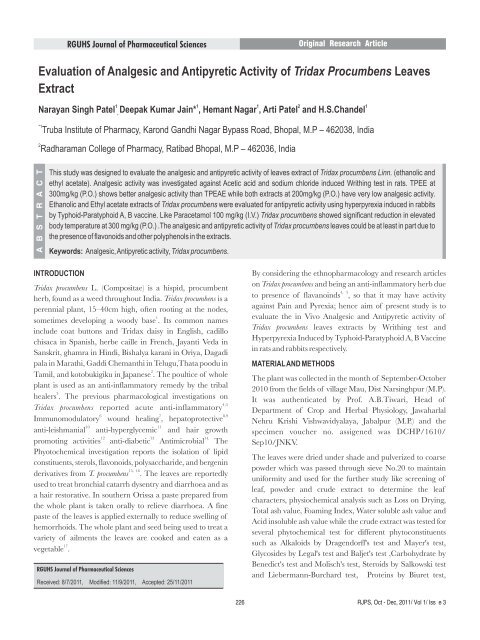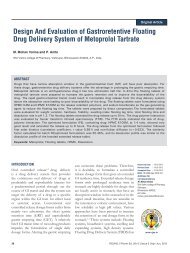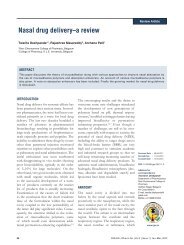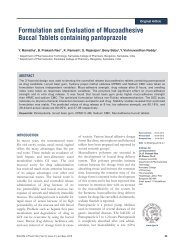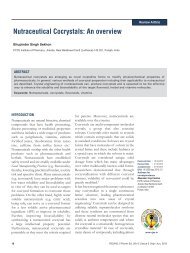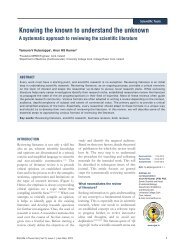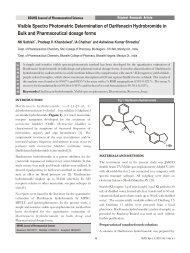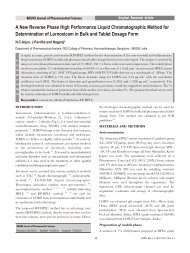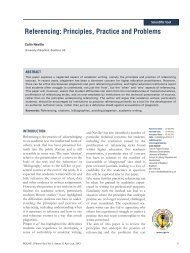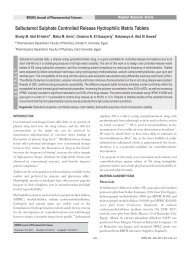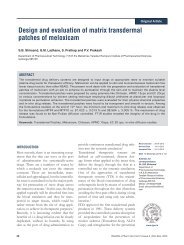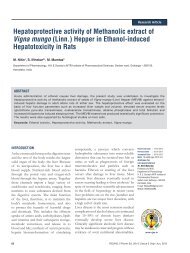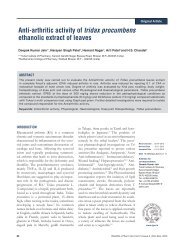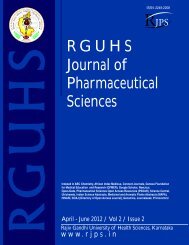Deepak Kumar Jain.pdf
Deepak Kumar Jain.pdf
Deepak Kumar Jain.pdf
Create successful ePaper yourself
Turn your PDF publications into a flip-book with our unique Google optimized e-Paper software.
A B S T R A C T<br />
RGUHS Journal of Pharmaceutical Sciences<br />
Evaluation of Analgesic and Antipyretic Activity of Tridax Procumbens Leaves<br />
Extract<br />
1 1 1 2 1<br />
Narayan Singh Patel , <strong>Deepak</strong> <strong>Kumar</strong> <strong>Jain</strong>* , Hemant Nagar , Arti Patel and H.S.Chandel<br />
*1<br />
Truba Institute of Pharmacy, Karond Gandhi Nagar Bypass Road, Bhopal, M.P – 462038, India<br />
2<br />
Radharaman College of Pharmacy, Ratibad Bhopal, M.P – 462036, India<br />
This study was designed to evaluate the analgesic and antipyretic activity of leaves extract of Tridax procumbens Linn. (ethanolic and<br />
ethyl acetate). Analgesic activity was investigated against Acetic acid and sodium chloride induced Writhing test in rats. TPEE at<br />
300mg/kg (P.O.) shows better analgesic activity than TPEAE while both extracts at 200mg/kg (P.O.) have very low analgesic activity.<br />
Ethanolic and Ethyl acetate extracts of Tridax procumbens were evaluated for antipyretic activity using hyperpyrexia induced in rabbits<br />
by Typhoid-Paratyphoid A, B vaccine. Like Paracetamol 100 mg/kg (I.V.) Tridax procumbens showed significant reduction in elevated<br />
body temperature at 300 mg/kg (P.O.) .The analgesic and antipyretic activity of Tridax procumbens leaves could be at least in part due to<br />
the presence of flavonoids and other polyphenols in the extracts.<br />
Keywords: Analgesic, Antipyretic activity, Tridax procumbens.<br />
INTRODUCTION<br />
Tridax procumbens L. (Compositae) is a hispid, procumbent<br />
herb, found as a weed throughout India. Tridax procumbens is a<br />
perennial plant, 15–40cm high, often rooting at the nodes,<br />
1<br />
sometimes developing a woody base . Its common names<br />
include coat buttons and Tridax daisy in English, cadillo<br />
chisaca in Spanish, herbe caille in French, Jayanti Veda in<br />
Sanskrit, ghamra in Hindi, Bishalya karani in Oriya, Dagadi<br />
pala in Marathi, Gaddi Chemanthi in Telugu,Thata poodu in<br />
2<br />
Tamil, and kotobukigiku in Japanese . The poultice of whole<br />
plant is used as an anti-inflammatory remedy by the tribal<br />
3<br />
healers . The previous pharmacological investigations on<br />
4,5<br />
Tridax procumbens reported acute anti-inflammatory<br />
6 7 8,9<br />
Immunomodulatory wound healing , hepatoprotective<br />
10 11<br />
anti-leishmanial anti-hyperglycemic and hair growth<br />
12 13 14.<br />
promoting activities anti-diabetic Antimicrobial The<br />
Phyotochemical investigation reports the isolation of lipid<br />
constituents, sterols, flavonoids, polysaccharide, and bergenin<br />
15, 16<br />
derivatives from T. procumbens . The leaves are reportedly<br />
used to treat bronchial catarrh dysentry and diarrhoea and as<br />
a hair restorative. In southern Orissa a paste prepared from<br />
the whole plant is taken orally to relieve diarrhoea. A fine<br />
paste of the leaves is applied externally to reduce swelling of<br />
hemorrhoids. The whole plant and seed being used to treat a<br />
variety of ailments the leaves are cooked and eaten as a<br />
17<br />
vegetable .<br />
RGUHS Journal of Pharmaceutical Sciences<br />
Received: 8/7/2011, Modified: 11/9/2011, Accepted: 25/11/2011<br />
226<br />
Original Research Article<br />
By considering the ethnopharmacology and research articles<br />
on Tridax procumbens and being an anti-inflammatory herb due<br />
4, 5<br />
to presence of flavanoinds , so that it may have activity<br />
against Pain and Pyrexia; hence aim of present study is to<br />
evaluate the in Vivo Analgesic and Antipyretic activity of<br />
Tridax procumbens leaves extracts by Writhing test and<br />
Hyperpyrexia Induced by Typhoid-Paratyphoid A, B Vaccine<br />
in rats and rabbits respectively.<br />
MATERIAL AND METHODS<br />
The plant was collected in the month of September-October<br />
2010 from the fields of village Mau, Dist Narsinghpur (M.P).<br />
It was authenticated by Prof. A.B.Tiwari, Head of<br />
Department of Crop and Herbal Physiology, Jawaharlal<br />
Nehru Krishi Vishwavidyalaya, Jabalpur (M.P.) and the<br />
specimen voucher no. assigened was DCHP/1610/<br />
Sep10/JNKV.<br />
The leaves were dried under shade and pulverized to coarse<br />
powder which was passed through sieve No.20 to maintain<br />
uniformity and used for the further study like screening of<br />
leaf, powder and crude extract to determine the leaf<br />
characters, physiochemical analysis such as Loss on Drying,<br />
Total ash value, Foaming Index, Water soluble ash value and<br />
Acid insoluble ash value while the crude extract was tested for<br />
several phytochemical test for different phytoconstituents<br />
such as Alkaloids by Dragendorff's test and Mayer's test,<br />
Glycosides by Legal's test and Baljet's test ,Carbohydrate by<br />
Benedict's test and Molisch's test, Steroids by Salkowski test<br />
and Liebermann-Burchard test, Proteins by Biuret test,<br />
RJPS, Oct - Dec, 2011/ Vol 1/ Issue 3
Flavonoids by Shinoda test and Alkaline reagent test also<br />
18, 19<br />
tested for Saponins and Tannins.<br />
Animals care and handling<br />
The experiments were carried out on albino rabbits of 5-8<br />
months of either sex weighing between 1.5 to 1.6 kg and<br />
Wistar albino rats of either sex of weight 150 ±20 grams.<br />
They were provided from Truba Institute of Pharmacy,<br />
Bhopal and were acclimatized to the standard laboratory<br />
conditions in well cross ventilated animal house at<br />
temperature 25±2°C relative humidity 44 –56% and light<br />
and dark cycles of 10 and 14 hours respectively for 1 week<br />
before and during the experiments. Rabbits were kept in mesh<br />
bottom iron cages to avoid caprophagy habit they fed with<br />
cauliflower, cabbage, carrot and water for 10 days before the<br />
experiment while Rats were fed with standard diet (Golden<br />
Feeds, Delhi) and water ad libitum. The experiments were<br />
approved by the Institutional Animal Ethics Committee and<br />
a s p e r C P C S E A g u i d e l i n e s ( a p p r o v a l n o .<br />
1196/a/08/CPCSEA).<br />
Drugs and chemicals<br />
Diclofenac sodium provided by Novartis pharmaceuticals<br />
Pvt. Ltd, Paracetabmol provided by Lupin Pharmaceuticals<br />
Pvt. Ltd., Typhoid-Paratyphoid A, B vaccine (Sanofi pasture)<br />
was purchased and all other chemicals utilized were of<br />
analytical grade.<br />
Acute toxicity studies<br />
The LD 50 was calculated by “Staire case” method. The LD50<br />
was determined in rats and mice by oral and intraperitonea1<br />
route. The initial dosing was 2000 mg/kg p.o. and 800 mg/kg<br />
4<br />
i.p. in both the species .<br />
Preparation of extract dose<br />
2% acacia suspension was prepared by suspending 2 gram of<br />
accurately weighed acacia powder in 100 ml of 0.9% saline.<br />
20 ml of vehicle was taken separately to which 2 gram of dried<br />
extract was added and sonicated, this produce suspension of<br />
100 mg/ml strength. Both TPEE and TPEAE suspension<br />
were prepared in such manner.<br />
Animal grouping<br />
Patel et al Evaluation of Analgesic and Antipyretic Activity of Tridax Procumbens Leaves Extract.<br />
For Analgesic activity, rats were divided into six groups and<br />
each group contains six animals. Group I (Negative control,<br />
vehicle treated), Group II (Standard, Diclofenac sodium)<br />
10mg/kg treated), Group III (TPEE 200mg/kg treated),<br />
Group IV (TPEE 300mg/kg treated), Group V<br />
(TPEAE200mg/kg treated), Group VI (TPEAE 300mg/kg<br />
treated).<br />
For Antipyretic activity, rabbits were divided into four groups<br />
227<br />
and each group contains four animals. Group I (Negative<br />
control, vehicle treated), Group II (Standard, Paracetamol<br />
100mg/kg treated), Group III (TPEE 300mg/kg treated),<br />
Group IV (TPEAE 300mg/kg treated).<br />
Screening of Analgesic Activity in Rats<br />
Acetic acid induced writhing test<br />
Acetic acid 1%v/v 1ml/100gm was injected intraperitonialy<br />
to animals of each group. Standard and test groups were<br />
treated with diclofenac sodium (I.P.) 15 minute and ethanolic<br />
extract, ethyl acetate extract (P.O.) 1 hour prior to the<br />
administration of acetic acid respectively while control group<br />
was treated with vehicle. Wriths were the stretching of the<br />
abdomen with simultaneous stretching of at least one hind<br />
limb. The total no. of wriths was recorded for 10 min starting<br />
20, 2<br />
10 min after injection of acetic acid.<br />
NaCl induced writhing test<br />
Sodium chloride 4%w/v at 1ml/kg concentration was<br />
injected intraperitonialy to animals of each group. Standard<br />
and test groups were treated with diclofenac sodium (I.P.) 15<br />
minute and ethanolic extract, ethyl acetate extract (P.O.) 1<br />
hour prior to the administration of Nacl respectively while<br />
control group was treated with vehicle. Then they were<br />
observed for a period of 10 min after 10 min of injection of<br />
acetic acid and the number of writhes is recorded for each<br />
20, 21<br />
animal. The percent inhibition of wriths was calculated.<br />
Screening of Antipyretic Activity in Rabbits<br />
Typhoid-Paratyphoid A, B vaccine 0.1 ml was injected into<br />
the marginal ear-vein of rabbits of each group. Standard and<br />
test groups were treated with paracetamol (I.V.) 15 minute and<br />
ethanolic extract, ethyl acetate extract (P.O.) 1 hour after the<br />
administration of Typhoid-Paratyphoid A, B vaccine<br />
respectively while control group was treated with vehicle. The<br />
rectal temperature each animal was recorded 15 minute<br />
before and at the interval of 30 minute after treatment using<br />
22<br />
Telethermometer up to 4 hours<br />
Statistical Analysis<br />
The results wereexpressed as mean ±SEM. The results of the<br />
present study were analyzed using one way ANOVA followed<br />
by dunnett's t-test computed statically by using Graph pad<br />
prism software (version 5.04).<br />
RESULTS<br />
Leaves were green, characteristic odour with slight bitter taste.<br />
Leaves were of size 3-5 cm in length and 1-1.5 cm width.<br />
There fracture was soft and rough texture. (Table 1). The<br />
findings of physiochemical analysis were that the total ash<br />
value was 6.6%, acid insoluble ash (2.5%), water soluble ash<br />
RJPS, Oct - Dec, 2011/ Vol 1/ Issue 3
Table 1: Morphological characteristics of leaves of<br />
Tridax procumbens.<br />
S.No. Characters Observation<br />
1 Color Green<br />
2 Odour Characteristic<br />
3 Taste Acridic<br />
4 Size 3-5cm lenght,1-1.5cm width<br />
5 Texture Rough<br />
6 Fracture Soft<br />
(1.14%), loss on drying was 0.1% and foaming index was less<br />
than 20%. These parameters suggest that the plant part<br />
contains nil moisture, have sufficient amount of organic<br />
content. (Table No.2). On performing several tests for<br />
Phyotochemical analysis on the ethanolic and ethyl acetate<br />
extract it was observed that both the extract contains<br />
appreciable amount of flavonoids and Phytosterols while<br />
other Phytoconstituents such as alkaloids, tannins, resins,<br />
proteins and carbohydrate were also present while they lack<br />
glycosides. (Table No.3). The Analgesic activity of Tridax<br />
Table 2: Physiochemical analysis of powdered leaves of<br />
Tridax procumbens.<br />
S.No. Parameters Observations (%)<br />
1 Loss on drying 0.1<br />
2 Foaming index 20<br />
3 Total ash value 6.6<br />
4 Acid insoluble ash value 2.5<br />
5 Water soluble ash value 1.14<br />
Patel et al Evaluation of Analgesic and Antipyretic Activity of Tridax Procumbens Leaves Extract.<br />
procumbens leaves extract was due to the presence of active<br />
Phytoconstituents which were determined in qualitative<br />
analysis of crude extracts. On administration of extract<br />
before I.P. administration of 1% v/v 1ml/100gm acetic acid<br />
leads to inhibition of wriths (Table No. 4). The Analgesic<br />
activity of Tridax procumbens leaves extract was due to the<br />
presence of active Phytoconstituents which were determined<br />
in qualitative analysis of crude extracts. On administration of<br />
extract before I.P. administration of 4%w/v 1ml/kg sodium<br />
chloride leads to inhibition of wriths (Table No. 5). The effect<br />
of TPEE and TPEAE after I.V. injection of 0.1 ml of<br />
Typhoid-Paratyphoid A, B vaccine into the marginal ear-vein<br />
of rabbits leads to decrease in temperature measured by<br />
telethermometer (Table No. 6)<br />
Fig. 1: Effects of TPEE and TPEAE on Acetic acid induced<br />
writhing response in rats CTR-Control, STD-Standard, TPEE-Tridax<br />
procumbens ethanolic extract, TPEAE-Tridax procumbens ethyl<br />
acetate extract (1-200mg/kg, 2-300mg/kg)<br />
Table 3: Phyotochemical Analysis of Tridax procumbens TPEE and TPEAE.<br />
S.N Phytoconstituents Test Ethyl Acetate Ethanolic<br />
extract(TPEAE) extract (TPEE)<br />
1 Carbohydrates Benedict’s test +ve +ve<br />
2 Proteins Biuret test +ve +ve<br />
3 Flavonoids Shinoda ’ s Test +ve +ve<br />
4 Alkaloids Mayer ’ s test, Dragendorff’s test +ve +ve<br />
5 Glycosides Legal’s test, Baljet’s test -ve -ve<br />
6 Saponins By shaking the extract in test tube +ve +ve<br />
7 Tannins Ferric chloride test +ve +ve<br />
8 Steroids Salkowski test +ve +ve<br />
Table 4: Effects of TPEE and TPEAE on Acetic acid induced writhing response in rats.<br />
Group No. Drug Dose Wriths % Inhibition of<br />
(Mean±SEM)<br />
wriths<br />
I Vehicle 1 ml/100gm 14.17±0.40 0<br />
II Diclofenac sodium 10 mg/kg 2.67±0.33 ** 81.2<br />
III TP Ethanolic extract 200 mg/kg 10.2±0.93 * 28.0<br />
IV TP Ethanolic extract 300 mg/kg 4.4±0.68 ** 68.2<br />
V TP Ethyl acetate extract 200 mg/kg 12.32±0.86 13.0<br />
IV TP Ethyl acetate extract 300 mg/kg 9.8±1.73 * 30.84<br />
TP-Tridax procumbens, N = 6, Data expressed as mean ± S.E.M, One way ANOVA followed by Dunnett's<br />
t-test Group I negative control, II standard, III, IV, V and VI test, All test and standard groups were<br />
ompared with group I (negative control) ** P
DISCUSSION<br />
Patel et al Evaluation of Analgesic and Antipyretic Activity of Tridax Procumbens Leaves Extract.<br />
Table 5: Effects of TPEE and TPEAE on NaCl induced writhing response in rats.<br />
Group No. Drug Dose Wriths % Inhibition of<br />
(Mean±SEM)<br />
wriths<br />
I Vehicle 1 ml/100gm 16.3±0.21 0<br />
II Diclofenac sodium 10 mg/kg 2.7±0.21** 83.4<br />
III TP Ethanolic extract 200 mg/kg 13.2±0.42* 19.0<br />
IV TP Ethanolic extract 300 mg/kg 4.7±0.51** 71.2<br />
V TP Ethyl acetate extract 200 mg/kg 14.52±1.05 10.9<br />
IV TP Ethyl acetate extract 300 mg/kg 12.58±1.12* 22.8<br />
TP-Tridax procumbens N = 6, Data expressed as mean ± S.E.M One way ANOVA followed by Dunnett's<br />
t-test Group I negative control, II positive control, III, IV, V and VI test. All test and standard groups were<br />
compared with group I (negative control) ** P
as compared to acetic acid which were inhibited up to 71.2%<br />
by 300mg/kg Tridax procumbens ethanolic extract and 22.8 %<br />
by 300mg/kg Tridax procumbens ethyl acetate extract as<br />
compared with the wriths of control group, whereas both<br />
extract at 200mg/kg inhibits wriths by 19.0% and 10.9%<br />
respectively. The 300mg/kg dose of Tridax procumbens<br />
ethanolic extract shows significant (P
Patel et al Evaluation of Analgesic and Antipyretic Activity of Tridax Procumbens Leaves Extract.<br />
20. Hajare SW et al. Analgesic and Antipyretic activities of Dalbergia<br />
sissoo Leaves. Ind JPharmacool. 2000; 32: 357 – 60.<br />
21. Vogel WH, Schölkens BA, Sandow J, Müller G, Vogel WF. Analgesic,<br />
anti-inflammatory and anti-pyretic activity. Vogel HG. Drug Discovery<br />
nd<br />
and Evaluation Pharmacological Assays, 2 edition. New York,<br />
Springer-Verlag Berlin Heidelberg, 2002; 716 – 7.<br />
22. Bhargava S et al. Evaluation of antipyretic activity of Sudarshan<br />
churna: an ayurvedic formulation. J. Res. Educ. Indian Med. 2008;<br />
34:7 – 16.<br />
23. Rang HP, Dale MM, Ritter JM, Flower RJ, Analgesic drugs. Rang HP<br />
th<br />
and Dale MM. Rang and Dale's Pharmacology 6 edition. Churchill<br />
Livingston, U.K., 2007; 588- 96.<br />
231<br />
24. Gosh MN, Some common evaluation techniques. Fundamentals of<br />
rd<br />
Experimental Pharmacology, 3 edition. Hilton and Company, Kolkata,<br />
2005; 176-7.<br />
25. Narayana Raj K, Reddy MS, Chaluvadi MR, Krishna DR. Bioflavonoids<br />
classification, Pharmacological, Biochemical effects and Therapeutic<br />
potential. Indian JPharmacool. 2001; 33:2 –16.<br />
Address for Correspondence<br />
<strong>Deepak</strong> <strong>Kumar</strong> <strong>Jain</strong>, Truba Institute of Pharmacy, Karond Gandhi Nagar Bypass<br />
Road, Bhopal (M.P.)–462038 (India).<br />
E-mail: jaindeepak2081@yahoo.com<br />
RJPS, Oct - Dec, 2011/ Vol 1/ Issue 3


